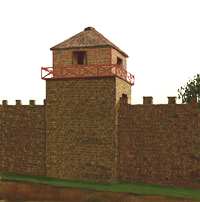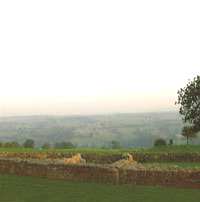Hadrian’s wall was 80 Roman miles long (73 modern miles), between
8 and 10 Roman feet (3 modern day meters) wide, and 5 meters high. Along
its length were eighty milecastles,
with two turrets
between each pair; 16 large forts, which could garrison 500-1000 men;
and small civilian towns called vici.
It is estimated that around one-million cubic meters of stone were used
to build the wall.


A reconstruction of a turret as it may have appeared, next to how it appears now
The design of the wall didn’t end with the wall itself. Also part of the wall’s environment was a vallum. The vallum was a flat-bottomed ditch, with a high earth mound on each side. It could only be crossed at a Roman fort or main road. This allowed the Romans even more control over the movement of the land’s people. There were probably around ten thousand men watching the border when the wall was first built.

Hadrian’s Wall is a unique work, as it is one of the first tangible barriers to be built by the Romans to mark their borders.
